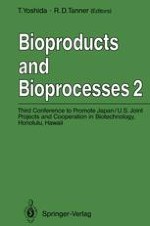Introduction During the week of January 6-10, 1991, the Third U.S.-Japan Conference on Biotechnology was held at the Asian-Pacific Conference Center at the Univer sity of Hawaii in Honolulu. This book is a compilation of the papers and posters presented at the Conference. The Conference was sponsored, in part, by the U.S. pharmaceutical companies including National Science Foundation and Ortho Pharmaceutical, Merck, Genentech, Smith Kline Beecham and ABEe. Its purpose was to promote information exchange between Japanese and U.S. researchers, primarily academics, in biotechnology and to seek ways to carry out collaborative research in biotechnology. The honorary chairmen of the Conference were Professor H. Okada and me. The formal program was organized by Professors 1. Bailey and T. Yoshida. Twelve invited formal presentations were given from each side. In addition, both sides were invited to bring along five observers to the Conference who were encouraged to prepare poster presentations on their research. Paper abstracts plus bibliographies were exchanged prior to the Conference in order to promote maximum technical interaction between the participants.
